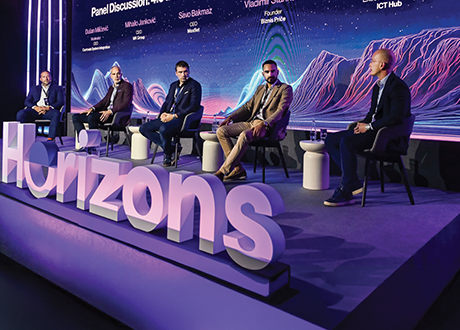Posted on September 24, 2015
Comtrade has ideas worth spreading
Ljubljana, Maribor, September 24, 2015, Marko Javornik, VP/GM Automotive at Comtrade was one of the 4 speakers at TEDx event that was held in the air, on the AIRBUS A319 between Ljubljana and Maribor on September 24. Javornik spoke about the digitalization of mobility.
Urban mobility is facing exciting and turbulent times. It seems that the era of complete dominance of privately owned cars is coming to an end. And this is happening for very good reasons. A privately owned car promises the freedom of mobility but with congestion and pollution in urban environments its value is diminished and the negative effects are increased. When bicycle becomes the fastest means of transportation on the streets, when people need to squeeze at the edge of the roads while our mobility infrastructure takes up almost all of the available space between buildings and when hundreds of people are dying prematurely each day because of transportation-related city pollution, it is time to rethink the future direction of urban mobility. This leads to the understanding and acceptance that the current transportation model is no longer sustainable and needs to be replaced with a model that is more efficient, cost-effective and environmentally friendly.
On the other hand, digitization is delivering new user experiences and new business models that can solve many of these pain points very efficiently and effectively.
Statistics are very simple – car is used less than 5 % of the day which means that for about 23 hours per day, a car is mainly causing problems. Since private vehicles are not used only for city trips they are not optimized for this purpose. People are buying fossil fuel cars because they need the car for the occasional long distance trip, even though the vast majority of drives are short trips for which an electric vehicle would be perfectly adequate. And when a trip is started with a private car, it will probably also be finished in the same way – it is not very convenient to mix it with other means of transportation.
If we embrace the Mobility-as-a-Service concept, the situation changes significantly. First of all, efficiency increases dramatically. On average, one shared car replaces about 10 privately owned cars. The shared cars can be optimized for a single purpose, which means cars in cities can be more compact with lower carbon footprint. They can also be larger, if that is what is needed. And along every step, users can change the mode of transportation to increase efficiency and flexibility.

Marko Javornik, TEDx Ljubljana v zraku
If we ignore the car as a status symbol, privately owned cars essentially have two main purposes:
- Providing the means to move from point A to point B
- Ensuring that mobility is available when we need it
Mobility-as-a-service can optimize both parameters. On the one side it can optimize the actual mobility part by selecting more appropriate vehicles and optimizing their use. However, the main advantage of this concept is that the vehicle no longer needs to sit idle in order to ensure that mobility will be available when the user needs it. This “mobility guarantee” is an information problem and we should solve it with information technology. In addition to significant economic benefits of having “mobility guarantee” done by a digital platform, the guarantee itself is also better because it can give us the following mobility option:
- the most appropriate transportation that fits best to your needs;
- transportation that is available to you at the time you need it;
- at the place that is the most convenient for you.
The MaaS model has obvious economic benefits for the end consumers. However, it also has significant community benefits, such as:
- Significant reduction of space required for transportation infrastructure. Just in terms of parking space in Ljubljana, it is estimated that about 300 soccer fields of surface would become available, if we transitioned to MaaS concept – without any negative impact on our parking space availability
- By using electric shared cars the pollution from the road transport within the city would be drastically reduced
- Using electric cars would also significantly reduce the noise level within the city
- Multi-modal mobility approach can be used very effectively to promote healthy forms of mobility (such as walking and biking).




